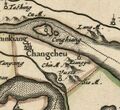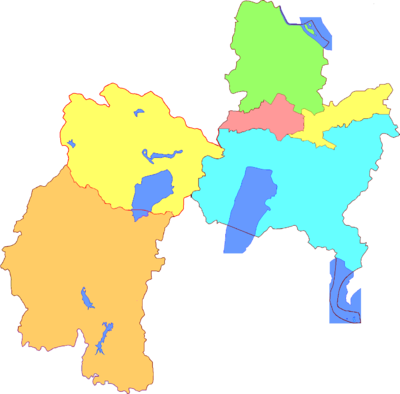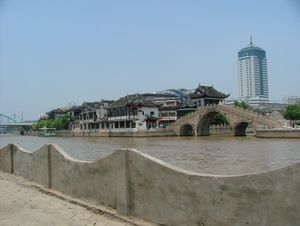تشانغتشو
تشانگژو
常州市 Changzhou | |
|---|---|
 | |
 | |
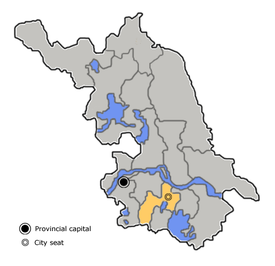 موقع نطاق مدينة چانگژو في جيانگسو | |
| الإحداثيات: 31°47′N 119°58′E / 31.783°N 119.967°E | |
| البلد | الصين |
| المقاطعة | جيانگسو |
| الأقسام | 5 districts, 1 city |
| الحكومة | |
| • أمين الحزب | يان لي |
| • العمدة | Fei Gaoyun (费高云) |
| المساحة | |
| • مدينة بمستوى محافظة | 4٬384٫58 كم² (1٬692٫90 ميل²) |
| • الحضر | 1٬872٫1 كم² (722٫8 ميل²) |
| التعداد (2010 census)[1] | |
| • مدينة بمستوى محافظة | 4٬592٬431 |
| • الكثافة | 1٬000/km2 (2٬700/sq mi) |
| • Urban | 3٬290٬918 |
| • الكثافة الحضرية | 1٬800/km2 (4٬600/sq mi) |
| • العمرانية | Shanghai-Suzhou-Wuxi |
| منطقة التوقيت | UTC+8 (China Standard) |
| Postal code | 213000, 213100 (Urban center) 213200, 213300 (Other areas) |
| مفتاح الهاتف | 0519 |
| GDP | 2010[1] |
| - Total | CNY 297.67 billion (USD 47.7711 billion) |
| - per capita | CNY 65000 (USD 10,431.12) |
| - Growth | ▲ 14.3% |
| License Plate Prefix | 苏D |
| Local dialect | Wu: Changzhou dialect |
| الموقع الإلكتروني | www.changzhou.gov.cn |
تشانغتشو (النطق الأصح: چانگژو؛ الصينية: 常州؛ إنگليزية: Changzhou) هي مدينة بمستوى محافظة في مقاطعة جيانگسو في جنوب الصين. وكانت تُعرف سابقاً بالأسماء: Yanling, Lanling, Jinling, و ووجين. وبوقوعها على الضفة الجنوبية لـنهر يانگتسى، تحد چانگژو عاصمة المقاطعة نانجينگ إلى الغرب، ژنجيانگ إلى الشمال الغربي، ووشي إلى الشرق، ومقاطعة ژىجيانگ إلى الجنوب. چانگژو هي جزء من منطقة دلتا نهر يانغتسي، عالية التنمية، في الصين والتي تمتد من شانغهاي متجهةً باتجاه الشمال الغربي، والتي تضم أكثر من 36,000,000 نسمة (شانغهاي-سوژو-ووشي). إجمالي تعداد المدينة كان 4,592,431 في تعداد 2010، منهم 3,290,918 كانوا يعيشون في المنطقة الحضرية المكونة من خمسة مديريات حضرية.[2] و هو ثاني أكبر تجمع عمراني بعد دلتا نهر اللؤلؤ. المدينة هي مسقط رأس ژو يوگوانگ مبتدع نظام الرومنة پنين.
| تشانغتشو | |||||||||||||||||
|---|---|---|---|---|---|---|---|---|---|---|---|---|---|---|---|---|---|
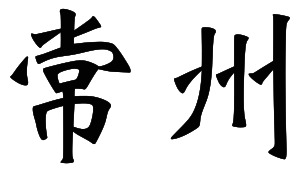 "Changzhou" in Chinese | |||||||||||||||||
| الصينية | 常州 | ||||||||||||||||
| |||||||||||||||||
التاريخ
"The Ruins of Yancheng" (淹城遺址), comprise the remains of a walled city located in the Wujin district of Changzhou that was founded over 3000 years ago at the beginning of the Western Zhou dynasty. The earliest record of a settlement on the site of modern Changzhou is as a commandery founded in 221 BC at the beginning of the Qin Dynasty. وفي فترة شغور العرش بين أسرتي سوي وتانگ، كانت مدينة Piling (毗陵) عاصمة Shen Faxing's short-lived مملكة ليانگ (AD 619 to 620). Changzhou got its present name meaning "ordinary prefecture" in 589. Following construction of the Grand Canal in 609, Changzhou became a canal port and transshipment point for locally-grown grain, and has maintained these roles ever since. The rural counties surrounding Changzhou are noted for the production of rice, fish, tea, silk, bamboo and fruit.
During the Taiping Rebellion of the 1850s, one of five palaces housing the leaders of the so-called "Kingdom of Celestial Peace" was constructed in Changzhou. Today the ruins of the "King's Palace" can be found near the People's No.1 Hospital.
In the 1920s, Changzhou started to attract cotton mills. The cotton industry got a boost in the late 1930s when businesses began relocating outside of Shanghai due to its Japanese occupation. On January 1, 1953, Changzhou was set as provincially administrated municipality.
In 1958, Zhenjiang Prefecture was renamed as Changzhou Prefecture, and the administration office was moved from Zhenjiang to Changzhou. Changzhou was incorporated by Changzhou Prefecture. In 1959, Changzhou Prefecture was changed into Zhenjiang Prefecture, and the administration office was moved from Changzhou to Zhenjiang. Changzhou was incorporated by Zhenjiang Prefecture. In 1960, Wujin County of Zhenjiang Prefecture was incorporated into Changzhou. In 1962, Changzhou was changed into provincially administrated municipality and Wujin County was incorporated into Zhenjiang Prefecture. Unlike many Chinese cities, Changzhou continued to prosper even during the upheavals of the 1966–76 Cultural Revolution. In 1983, when the municipally affiliated county system was carried out, Wujin County, Jintan County and Liyang County of Zhenjiang were incorporated into Changzhou. The urban area was divided into five municipally administrated districts, Guanghua, Tianning, Zhonglou, Qishuyan and Jiaoqu. At that time, Changzhou administrated three counties and five districts. From September 1986, as approved by State Council, Guanghua District was revoked and the previous administrative area was incorporated into Zhonglou District and Tianning Districrt. Liyang County was changed into Liyang City (county level). At that time, Changzhou administrated one city, two counties and four districts. In 1993, Jintan County was changed into Jintan City. In 1995, Longhutang Town, Xinqiao Town, Baizhang Town and Weitang Town of Wujin County were incorporated into Jiaoqu District. As approved by State Council on June 8 of 1995, Wujin County was promoted to Wujin City, with the government set in Hutang Town. In 1999, as approved by the provincial government, Taixiang Town of Jiaoqu District was revoked and incorporated into Xueyan Town of Wujin City.[3] Today, Changzhou is an industrial center for textiles, food processing, machinery such as diesel engines, generators, and transformers, and high technology. The rural counties surrounding it are noted for the production of rice, fish, tea, silk, bamboo, and fruit.
Changcheu Prefecture between the Yangtze and Lake Tai, from Martino Martini's 1655 Novus Atlas Sinensis.
The Grand Canal at Changzhou in 2006.
المناخ
Changzhou has a wide range of temperature differences throughout the year.
| بيانات المناخ لـ چانگژو (1971–2000) | |||||||||||||
|---|---|---|---|---|---|---|---|---|---|---|---|---|---|
| الشهر | ينا | فب | مار | أبر | ماي | يون | يول | أغس | سبت | أكت | نوف | ديس | السنة |
| متوسط القصوى اليومية °س (°ف) | 7.1 (44.8) |
8.6 (47.5) |
12.9 (55.2) |
19.6 (67.3) |
25.1 (77.2) |
28.3 (82.9) |
31.8 (89.2) |
31.6 (88.9) |
27.1 (80.8) |
22.2 (72.0) |
16.0 (60.8) |
10.0 (50.0) |
20.0 (68.0) |
| متوسط الدنيا اليومية °س (°ف) | 0.0 (32.0) |
1.4 (34.5) |
5.2 (41.4) |
10.9 (51.6) |
16.3 (61.3) |
20.9 (69.6) |
25.0 (77.0) |
24.7 (76.5) |
20.1 (68.2) |
14.3 (57.7) |
7.9 (46.2) |
2.0 (35.6) |
12.4 (54.3) |
| متوسط تساقط الأمطار mm (inches) | 44.6 (1.76) |
53.7 (2.11) |
89.2 (3.51) |
81.2 (3.20) |
102.4 (4.03) |
189.3 (7.45) |
171.7 (6.76) |
116.1 (4.57) |
92.2 (3.63) |
68.7 (2.70) |
52.7 (2.07) |
29.6 (1.17) |
1٬091٫4 (42.96) |
| Average precipitation days (≥ 0.1 mm) | 8.7 | 9.8 | 13.0 | 11.4 | 11.7 | 12.8 | 12.8 | 11.3 | 9.5 | 8.7 | 7.0 | 6.1 | 122.8 |
| Source: [4] | |||||||||||||
الادارة
The prefecture-level city of Changzhou administers seven county-level divisions, including five districts and one county-level city.
| الخريطة | القسم | Hanzi | Pinyin | التعداد (2010) | المساحة (كم²) | الكثافة |
|---|---|---|---|---|---|---|
| City Proper | ||||||
| Zhonglou District | 钟楼区 | Zhōnglóu Qū | 505,762 | 66.86 | 7,564 | |
| Tianning District | 天宁区 | Tiānníng Qū | 513,794 | 65.15 | 7,886 | |
| Suburban | ||||||
| Xinbei District | 新北区 | Xīnběi Qū | 596,807 | 425 | 1,404.25 | |
| Wujin District | 武进区 | Wǔjìn Qū | 1,569,034 | 1,278.22 | 1,259 | |
| Jintan District | 金坛区 | Jīntán Qū | 551,991 | 976.26 | 565 | |
| Satellite cities (County-level cities) | ||||||
| Liyang | 溧阳市 | Lìyáng Shì | 749,522 | 1,536.24 | 488 | |
| Total | 4,592,431 | 4,384.58 | 1,047 | |||
- Dissolved district: Qishuyan District
الاقتصاد
Changzhou's traditional role has been that of a commercial center and in particular a distribution center for agricultural produce, which was shipped by canal to the north and later, to Shanghai. The city began to develop a cotton textile industry in the 1920s, and cotton mills were established in the late 1930s, when Japanese attacks drove many Chinese businesses to invest outside Shanghai.
The city has remained a textile center and the most important location في مقاطعة جيانگسو for weaving[بحاجة لمصدر]. It also has large food-processing plants as well as flour-milling, rice-polishing, and oil-pressing industries. After 1949 it also developed as a centre of the engineering industry. Qishuyan, some 10 كيلومتر (6.2 mi)* southeast of Changzhou, has one of the largest locomotive and rolling stock plants in China. Other engineering works in Changzhou produce diesel engines, generators, transformers along with agricultural and textile machinery. At the time of the Great Leap Forward in 1958 a steel plant was also built to provide raw material for heavy industry.
Since 1908, Changzhou has been linked by rail with Shanghai and Nanjing (see below for transportation).
Up until now, Changzhou has remained one of the most developed cities في جيانگسو، ranked third after Suzhou and Wuxi. The city's 2009 GDP per capita of ¥70,103 in 2009, less than that of Suzhou and Wuxi but more than the capital city Nanjing, ranked the city third في جيانگسو.
Changzhou is also one of the top business cities in China. According to Forbes ranking, Changzhou was the 9th best business city in mainland China in 2008.
الثقافة والفولكلور
The Changzhou dialect is a member of the Wu Chinese language family.
Other famous handicrafts of Changzhou are silk embroidery in a "crisscross" style and carvings made from green bamboo.
Noted snacks made in Changzhou include pickled radish, sesame candy, sweet glutinous rice flour dumpling with fermented glutinous rice, and silver thread noodles (also known as dragon's beard noodles).
Since 2004, Changzhou has successfully hosted China (Changzhou) International Cartoon and Digital Art Festival (CICDAF) for three times successively. With the 3-year efforts, CICDAF has basically reached the level of an international cartoon and movie festival, having vast and active influence on both the foreign and domestic cartoon industry. It has become one of the most professional and authoritative international cartoon events at the highest level. It gives new connotation to the cultural development in Changzhou, and Changzhou has ranked as the only municipal city among the first 9 “national animation and cartoon industrial bases” in China. Up to now, there are 3 incubator parks in the base with nearly 60 enterprises registered and the registered capital of nearly RMB 3 million. This year, the number of cartoons produced in the base and set by the National Bureau of Broadcasting and Television has reached 70, that is, 4,500 volumes and 50,000 minutes. A group of distinguished works have been up and coming, including the Peach Blossom Fan, which has gained many rewards both oversea and domestically. On December 12, 2006, Changzhou National Cartoon Industrial Base was awarded as “Top Ten Innovative Base with the Largest Investment Value of 2006”.[5]
السياحة
منتزهات ترفيهية
Changzhou is the home of the China Dinosaurs Park located in the Xinbei District of the city. The 5A rated Dinosaur Park has a collection of dinosaur bones and fossils from all over China. The park has 50 various fossils and more than 30 amusement programs including the Brontosaurus Roller Coaster and the Whirling Dinosaur Carriage. The fossils are located in a museum housed in a single building and the amusement rides are spread throughout the park which is categorized into six themed areas. Besides fossils and family oriented rides, Dinosaur Park is home to a giant panda and sea lions.[6]
In 2011, a new amusement park called CC Joyland (الصينية المبسطة: 环球动漫嬉戏谷; الصينية التقليدية: 環球動漫嬉戲谷; پنين: Huánqiú dòngmàn xīxì gǔ) opened in Taihuwan near Taihu lake in Wujin District in the south of Changzhou.
As a National 4-A Tourist Resort of Changzhou, China Dinosaur Park is the sample base of the national science popularization education and the Chinese cultural industry. It is also a National 4-A Class Amusement Park that perfectly combines museum, hi-tech acoustic, optic and electric technology, special video effects and multimedia network and that integrates exhibition, science popularization, entertainment, leisure and participatory performances. Its central building and the core of the park is China Dinosaur Museum, which was the cooperative project of Changzhou Municipal government and the Ministry of Land and Resources (the former Ministry of Geology and Mineral Resources). It presents to the society with the most precious geological minerals through the advanced supporting facilities. The park is Pided into several parts, including China Dinosaur Museum, On-lake lawn, biological performance of the dinosaur mountain, leisure area for foreign investors and aggressive project area, etc. These parts let people feel the mysterious atmosphere of the ancient years, to see the appearance of dinosaurs, and to enjoy the modern travel atmosphere full of surprise and risks. As one of the cards of Changzhou, China Dinosaur Park, together with other scenic spots, is featuring Changzhou into a new tourist landmark in east China.[7]
معبد تيانننج ومنتزه هونجمـِيْ
The city is also home to the Tianning Temple—one of the largest Zen Buddhist temple and monasteries in China. The city recently rebuilt the Tianning pagoda in the temple grounds, which is adjacent to Hongmei Park. The pagoda, called the Tianning Baota, was first built during the Tang Dynasty (AD 618 - 907). Since that time it has been destroyed and rebuilt five times. The current reconstruction is built to the height specification of 153.79 m (504.6 ft). This makes it the tallest pagoda in China and perhaps also the world. Both the Hongmei Park and Tianning Temple are located just to the east of the city centre.[8]
There is the Hong Mei Park, which includes a small children's amusement park, a zoo, a rose garden and many scenic waterways. Of historical interest in the park is a historical pavilion with exhibits related to the Changzhou comb industry. In addition, there is another pavilion which displays locally produced root carvings. The park attracts large numbers of people during holidays and is often dotted with a variety of vendors. However, the Hongmei Park has been criticized for animal abuse and overpricing in its aquarium. Tianning Temple and Hongmei Park are served by the Hongmei Park station on Line 2 (Changzhou Metro).
As Changzhou is noted for its combs, the city has reconstructed its Fine Comb Lane area with contemporary architecture. Changzhou combs can be purchased in most places in the city.
Other sites include Changzhou's sunken city and area of archaeological ruins from the Spring and Autumn period.
Dongpo Park is located in the east part of downtown of Changzhou city, and its original name is Dongjiao Park. It covers 2.667 hectares, and is a typical Jiangnan Garden composed of cultural sites and natural landscape. During the time of south Song dynasty, the civilians of Changzhou established Yizhou Pavilion to commemorate, Su Dongpo, who was the great literature master and used to come to Changzhou. During the time of Qing dynasty, Kangxi and Qianlong, two emperors southwardly visited, they ordered to build up the temporary palace here and reconstructed this pavilion.
Changzhou also has attractive gardens such as the Wei Yuan. The Old Museum of Wisteria is also located in the city.
مدن شقيقة
 Takatsuki, Osaka Prefecture, Japan
Takatsuki, Osaka Prefecture, Japan Hurstville, New South Wales, Australia
Hurstville, New South Wales, Australia Torrington, Connecticut, United States of America
Torrington, Connecticut, United States of America Solihull, England, United Kingdom
Solihull, England, United Kingdom Dar es Salaam, Tanzania
Dar es Salaam, Tanzania Prato, Italy
Prato, Italy Buffalo, New York, United States of America
Buffalo, New York, United States of America Rockford, Illinois, United States of America
Rockford, Illinois, United States of America Arad, Romania
Arad, Romania Netanya, Israel
Netanya, Israel Wyndham, Australia
Wyndham, Australia Curitiba, Brazil
Curitiba, Brazil Minden, Germany
Minden, Germany Essen, Germany
Essen, Germany La Serena, Chile
La Serena, Chile Niagara Falls, Canada
Niagara Falls, Canada Johor Bahru, Malaysia
Johor Bahru, Malaysia Tilburg, Netherlands
Tilburg, Netherlands Satakunta, Finland
Satakunta, Finland Jelenia Gora, Poland
Jelenia Gora, Poland Lommel, Belgium
Lommel, Belgium Randers, Denmark
Randers, Denmark Tomsk, Russia
Tomsk, Russia Stavropol, Russia
Stavropol, Russia Tokorozawa, Japan
Tokorozawa, Japan Namyangju, South Korea
Namyangju, South Korea Chuncheon, South Korea
Chuncheon, South Korea Eskişehir, Turkey
Eskişehir, Turkey Beau Bassin-Rose Hill, Mauritius
Beau Bassin-Rose Hill, Mauritius
أشخاص بارزون
- Su Dongpo (Su Shi; 1036–1101), poet and essayist.
- Sheng Xuanhuai (1844–1916), late Qing Dynasty bureaucrat and reformer.
- Lü Simian (1884–1957), historian and member of the Doubting Antiquity School
- Zhao Yuanren (1892–1982), prominent linguist.
- Hong Shen (1894–1955), pioneering dramatist and filmmaker was born here.
- Yun Daiying (1895–1931), revolutionary and pioneer of early Communist Youth activities.
- Liu Haisu (1896–1994), prominent artist.
- Zhang Tailei (1898–1927), one of the founders of Chinese Communist Party, first Chinese ever working in Communist International.
- Qu Qiubai (1899–1935), former General Secretary of the Communist Party of China and prominent Marxist thinker and writer. Named "Changzhou San Jie" together with Yun Daiying and Zhang Tailei.
Qu Qiubai, Zhang Tailei and Yun Daiying, who are called “three heroes of Changzhou”, were earlier Party leaders. They fought for the reform of China and sacrificed themselves. As one of the earlier leaders of the Party, Qu Qiubai was a Marxist, an excellent proletarian revolutionist, theorist and publicist as well as one of the founders of the revolutionary literature in China. Zhang Tailei is a name closely related to foundation of Socialist Youth League and Guangzhou Uprising. He was one of the earliest international activists in the Party as well as the link between the Party and Communist International, Youth League and Youth Communist International. He was called the “real internationalist”. Yun Daiying was one of the early Party leaders. He was also a political scientist, theorist, and leader of youth movements. He participated into and led the May Fourth Movement, the May 30th Movement, Nanchang Uprising, and Guangzhou Uprising, etc. Having been influenced by him, numerous young people stepped onto the road of reform. “Three heroes of Changzhou” are the representatives of the celebrities of Changzhou, and they will be the pride of Changzhou people.[9]
- Zhou Youguang (1906–2017), linguist often credited as the "father of Hanyu Pinyin"
- Hua Luogeng (1910–1985), prominent mathematician.
- Xie Zhiliu (1910–1997), prominent painter.
- Tang Jun (1962–), former President of Microsoft in China.
- Lu Lan (1987–), Olympic athlete and badminton player. Won the woman's championship at the 2009 BWF World Championships.
انظر أيضاً
الهامش
- ^ أ ب "Changzhou ( Jiangsu ) City Information" (in Chinese). Changzhou Municipal Statistic Bureau. 2010-03-01. Retrieved 2010-06-30.
{{cite web}}: CS1 maint: unrecognized language (link) - ^ http://www.citypopulation.de/php/china-jiangsu-admin.php
- ^ "Historical Changes". Archived from the original on 2018-12-25. Retrieved 2018-12-25.
- ^ Weather China
- ^ "Culture Card". Archived from the original on 2018-12-25. Retrieved 2018-12-25.
- ^ 中华恐龙园官网. www.cnkly.com. Archived from the original on 2009-01-18. Retrieved 2009-01-17.
- ^ "Tourism Card". Archived from the original on 2018-12-25. Retrieved 2018-12-25.
- ^ "Buddhists gather to inaugurate world's tallest pagoda". China Daily. Xinhua. 2007-04-30. Archived from the original on 2007-12-09. Retrieved 2007-04-30.
- ^ "Figure Card". Archived from the original on 2018-12-25. Retrieved 2018-12-25.
وصلات خارجية
- Government website of Changzhou (صينية)
- Changzhou city guide with open directory (Jiangsu.NET)
- The history and culture of Changzhou city (Mildchina.com)
- Café Zeeland - The first European style café of Changzhou (صينية)
- CS1 uses الصينية-language script (zh)
- Short description is different from Wikidata
- Articles containing صينية-language text
- Pages using gadget WikiMiniAtlas
- Articles containing Chinese-language text
- Articles containing إنگليزية-language text
- Pages using Lang-xx templates
- Pages using image label with a wide image
- Pages using image label with a tall image
- Articles with unsourced statements from December 2010
- Convert invalid options
- Articles containing simplified Chinese-language text
- Articles containing traditional Chinese-language text
- مدن جيانگسو
- چانگژو
- مدن الحدائق الوطنية في الصين
- صفحات مع الخرائط

